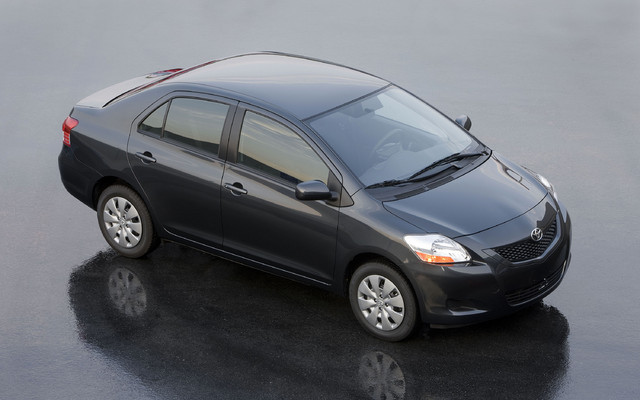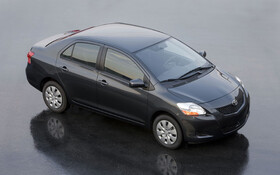2010 Toyota Yaris: An Idiosyncratic Toyota?!

| Strong points |
|
|---|---|
| Weak points |
|
When Toyota builds a car, they generally do it right. As in, by the book; every button in its place, every part appropriately robust. Be it the lowly Corolla or the extremely luxurious LS600hL, Toyota’s built their reputation on ensuring that every facet of every vehicle is sufficiently well designed so as to keep any criticism at bay.
But (and there always is a “but,” is there not?), as is always the case, time erodes everything, excellent engineering included. And while my first meeting with the then-new Toyota Yaris left me impressed, the passage of three years’ time has brought about a few changes in perspective. The debut of the second-generation Honda Fit and Ford’s incredible Fiesta has instilled slightly higher standards amongst the car-buying public, and my second round aboard Toyota’s Yaris revealed precisely where it fits amongst its rivals.
First, there’s the look. In two door hatchback form, it’s a pretty cute little vehicle; of that there’s no denying. But, as tested in four door sedan mode... well... suffice it to say that its beauty escaped the eye of this beholder. No one expects the graceful lines of an Aston Martin, but the Yaris it simply too good at blending in. Perhaps a colour palette with a bit more pigment might cure that issue, but in the same granite-inspired dark hue that seemingly every other Yaris sedan wears, my tester made parking lots a vehicular version of Where’s Waldo.
Of course, those same short overhangs that hide behind minivans and SUVs outside the local Home Hardware also keep it small and manoeuvrable in tight confines. Flitting through traffic with ease, its compact dimensions inspire confidence. Sadly, the exercise of driving would be infinitely more enjoyable if the Yaris was imbued with a seating position that could be considered even close to comfortable. With an incredibly upright seat that sits too high and a steering wheel that would make most bus drivers feel at home, the sensation is something akin to that of driving a car equipped with a driver’s stool. Sure, the seats are soft and yet supportive, they’re just mounted in all the wrong ways.
Not unlike the cupholders. Yeah, yeah, scoff away, but when it comes to commuter cars, they’re somewhat important. And why Toyota decided to mount theirs right in front of the heater vents, I’ll never know. Toss some water in there on your way back from the gym on a cold winter’s day and you’ll be ready to make a nice steaming cup of coffee ala water bottle when you get back home. And since all your hot air’s been busy heating up your Dasani, you’ll want it. Trust me.
But it’s not all automotive idiosyncrasies. The 1.5L four cylinder is a real gem, for example. A motor that provides a modest 106 horsepower, it won’t set any acceleration records, but does is fantastically flexible. Saddled with just four gear ratios when equipped with the automatic, it still provides enough thrust for most passing manoeuvres, and is never caught flat-footed. Eager to please, it runs rings around the tachometer with ease and exuberance, but is just as happy to chuff along in stop-and-go traffic.
Likewise, the handling is equally broad in its bandwidth. Intended to appeal to a wide range of drivers, the Yaris’ steering is predictably light, being of the electronically boosted variety. Subsequently, there’s not a lot of feel to be found, but there doesn’t need to be: with just 185 millimetres of tread width at all four corners, the limits of adhesion are easily overcome with delightful results. Already a light car, the sedan’s body places just enough weight over the back tires that a quick stab of left-foot braking can overcome the available grip. And given the importance in maintaining as much momentum as possible, it’s nice to be able to correct for overly exuberant entry speeds.
Dial it back from the almost-too-attainable max attack level that’s a bit too fun, and the Yaris’ suspension still performs admirably. It soaks up most irregularities, but does make quite a bit of noise while doing so. Likewise, crosswinds and buffeting move the Yaris around a bit more than expected, and while the tires don’t provide a ton of grip, they have an interesting knack for falling into grooves and irregularities. Subsequently, longer highway-borne treks can get tiresome, requiring more focus than would be necessary in other vehicles. Furthermore, with just four ratios to choose from when equipped with the automatic, the 1.5L proves itself somewhat short-legged; spinning at a frenetic pace to keep up with highway traffic.
So, to answer the initial question I posed, the passage of time has seen the Yaris slide out of the compact car throne it occupied three years ago. While one wouldn’t expect a vehicle like the Yaris to excel in anything other than its native urban environment, the Ford Fiesta has significantly changed the automotive landscape as buyers demand more from their post-recession vehicles than ever before. And although the Yaris is an efficient and probably reliable automobile that offers excellent value for its bargain basement price, but it’s few foibles stand in the way of true excellence.











